| Report Type | Full |
| Peak(s) |
Grand Teton, 13,775' |
| Date Posted | 08/13/2023 |
| Modified | 08/14/2023 |
| Date Climbed | 08/11/2023 |
| Author | Ericsheffey |
| Grand Teton - Climbing the Upper Exum |
|---|
|
"The Best of Backup Plans"
The Backstory As with my other trip reports, I'll start by providing a little bit of a context to this trip. I was first introduced to the world of peakbagging back in 2019 with my first ever 14er summit, Longs Peak via the Keyhole Route. I had never heard of "class 3" before, nor had I ever done much of any intentional peakbagging. That same summer, I had been taken on my first outdoor rock climb, and although it was an incredible experience, I thought that there was no way I could ever "lead" climb outdoors, let alone take up multi-pitch climbing or any sort of technical alpine climb. Slowly but surely, a few friends of mine taught me the basics of ropework and leading, and encouraged me to start leading climbs of my own at the local crags around Denver. As I continued to knock out the 14ers and become more comfortable with steeper and more technical terrain, the allure of class 5 alpine climbing began to grow. As outlined in another TR of mine, as I slowly built my climbing resume, my brother-in-law, Nathan, moved to Colorado and began tackling 14ers and learning how to lead climb as well. We both started itching to learn how we could take our technical skills and apply them to alpine peaks that otherwise would be out of reach for us. Fast forward to August of 2021, I was approached by my good friend Matt Adkins to see if I'd be interested in teaming up for an unguided attempt at the Grand Teton via the Owen-Spalding Route. As this was my first opportunity for a technical alpine summit that would require the use of ropework and technical gear, I immediately said yes. That trip was a wild ride in and of itself, but in the end, we successfully climbed the OS to reach the summit of the Grand despite the thick wildfire smoke that made me sick as a dog the whole climb. That climb will forever be a monumental moment for me as an alpine climber, but I would be remiss in not recognizing that Matt spearheaded the bulk of that climb. After that summit however, I knew that I wanted to keep chasing technical peaks, and so I began to really start putting in the work in order to feel comfortable spearheading climbs like this on my own. 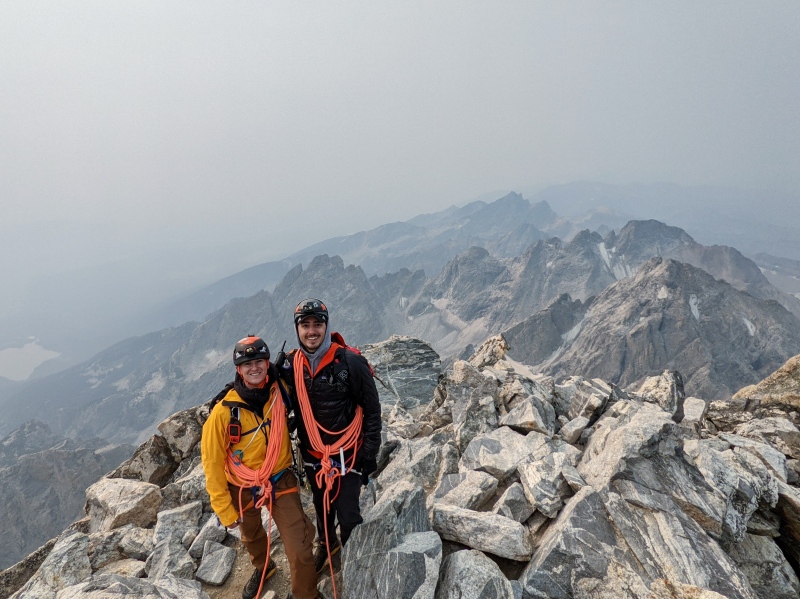
As I continued to work on developing my skills and knowledge as a climber, gaining valuable mentors in the trad climbing and ice climbing world, as well as spending time with various AMGA and IFMGA mountain guides, I slowly but surely started tackling other big technical climbs. As Nathan also shares a similar work schedule to mine, we ended up becoming primary climbing partners and working together to form a tic-list of mountain objectives. Some of our biggest climbs together have been Mt. Rainier via the Emmons, the Sharkstooth in RMNP via the NE Ridge, various ice climbs across the state, and even some adventurous peak bagging in Utah. Nathan had been to GTNP and mentioned how impressive the Grand Teton appeared from the valley, and I told him that I would love to go back up there and tag the summit again, not only because I see it as a great investment into our climbing partnership, but also because I'd love to see what the views are like without all the wildfire smoke that characterized my last climb of the Grand. So, we set aside three days in August of this year (8-10) for a strike mission from Denver to GTNP to summit the Grand Teton, assuming that we could cruise right up the Owen-Spalding route in summer conditions. We even did a day of private instruction in Eldo with Jeff Mascaro (AMGA Rock Guide / Smile Mountain Guides) to make sure we were both up to speed on alpine climbing techniques that could be applied on the Grand Teton (kiwi coils, short pitching, short roping, terrain belays, belayed downclimbs, etc). Despite all this preparation and planning for the OS, mother nature had other plans... The Week of the Climb I had been occasionally keeping tabs on the blog updates from the GTNP Rangers regarding climbing conditions, and was stoked to see that summer conditions were in full swing in the weeks leading up to our climb. About a week before our intended climbing dates, I began checking the three weather sources I use most in the mountains: NOAA, OpenSummit/OpenSnow, and Mountain Forecast. All three were advising of wind chills in the single digits on the Grand, with upwards of 8 inches of snow to be dumped on the mountain just days before our intended summit. I started texting Nathan and voicing some concerns about our planned trip. Nathan, who viewed this trip as a potential great learning experience regardless of summit success, continually reminded me that if we want to keep diving deeper into the world of alpinism, we should keep our plans intact to make an attempt, and that we should just be cautious and prepared to bail at any time. Although I was a little apprehensive, I knew that he was right. We have gear to climb in all types of conditions, and so we should bring what we think we might need and make an honest attempt. Before long, the week arrived and it was time to head to Wyoming. I got off work at 0500 hours and we were leaving from my apartment complex by 0700 hours, Nathan behind the wheel while I tried my best to get some sleep on the ride there. We continued checking the weather, and soon learned that it was actively snowing on the Grand Teton as we were driving to Wyoming. We solicited some beta/conditions updates on Facebook, and learned that even guides were being turned around on the OS this week, and that ice tools and crampons were going to be a bare minimum for a successful summit. I proposed a couple of other ideas, such as stopping in Vedauwoo for a few days of dedicated climbing there as a consolation prize instead of getting shut down on the Grand without even touching dry rock. I could tell Nathan still wanted to give it an honest go, even if we only were to get as high up as the Eye of the Needle before turning around. It was at this time that I was reminded via a thread on Facebook that the Upper Exum is only rated 5.5 (as opposed to the OS at 5.4), and follows the south ridge of the mountain, thus getting far more sunlight than the shaded OS. I asked Nathan if he'd be comfortable going for the Upper Exum instead, and he agreed instantly. I began looking up beta for the route as we continued towards GTNP, and although we read a few sections would be run out, we felt it was well within our abilities and would still be a great venue to practice alpine rope skills as a team. The last caveat to our new plan would be that the day that we had planned to summit (August 10th), the mountain was forecasted to see winds of 50mph with gusts of 70mph, which made the prospect of run-out slab climbing a little intimidating. We arrived at Jenny Lake Ranger Station late in the day and checked in with the Rangers. They confirmed our concerns about the winds, but said that there was permit availability for the Moraines on Wednesday night, and that if we picked up that permit, they could go ahead and add on Thursday night for us, giving us the opportunity to summit Friday morning (August 11th) after the winds had died down. Even though both Nathan and I were scheduled to work in Denver on Friday night, we agreed we would call out sick and commit to this climb instead. Our final plan was to take those camping permits, and if the forecast changed for the better, to make an attempt on Thursday, and if it didn't, to make an attempt on Friday. We left the ranger station with camping permit in hand, and found some dispersed camping outside of Jackson for the night. The following morning we made one final stop for food, then headed to the trailhead where we would begin our multi day adventure. The Start of the Climb - The Approach through Garnet Canyon 
Although I had done the approach through Garnet Canyon once before, I think I had largely forgotten how big of a day it is to get to the upper camping sites. For the first several miles, the trail is fairly well maintained, mostly dirt, with tourists and casual hikers all over. I think most hikers accessing the TH are there just to hike to one of the several lakes in the area. Be prepared to field many questions from curious hikers in regards to the ropes on your packs. Anyways, the first few miles flew by rather quickly, but the trail begins to change rapidly once entering Garnet Canyon. As you enter Garnet Canyon, you are greeted with immense views of the Middle Teton, as well as the first of several boulderfields. 

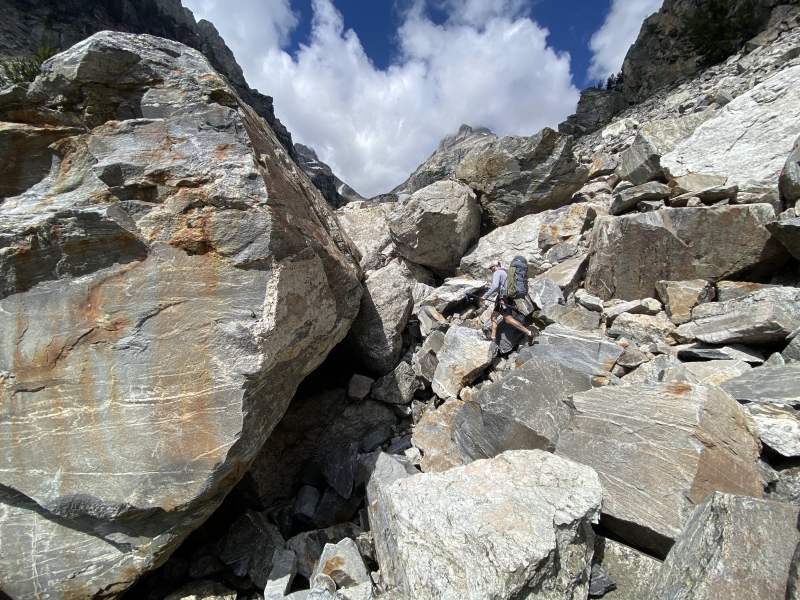
It's been said that Garnet Canyon is essentially one big boulderfield, but I disagree. There is actually some really pleasant single track trail that connects the various boulderfields. Regardless, those short sections come with the thigh workout of a lifetime due to the weight of a backpacking pack full of three days of goods, a rope, and climbing rack. Soon enough we ascended up past the last boulderfield located just before the start of the morainal camping zone, where we had our camping permits. We were pretty exhausted and so we set up our home away from home at the first of the designated camping sites in the morainal zone and started to cook dinner. 
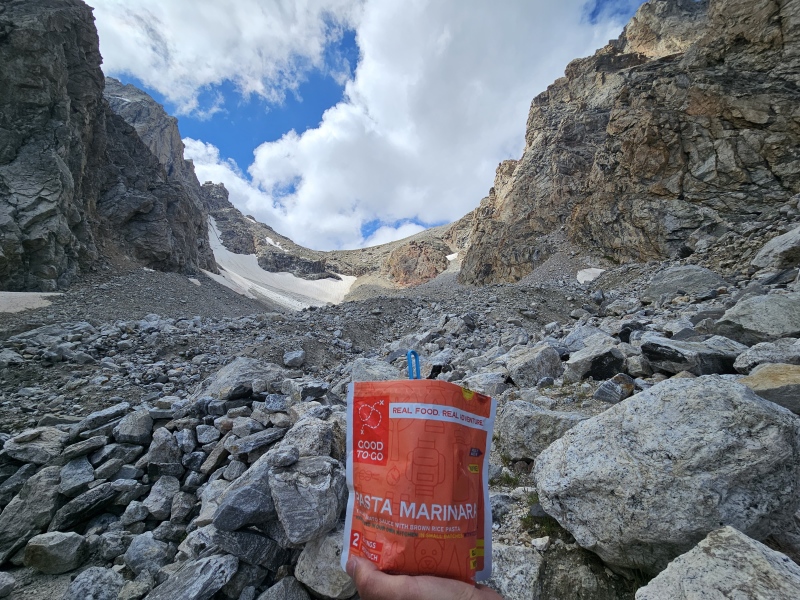
Soon enough we called it a night and went to sleep with our alarms set for 2am, just in case the weather forecast would change and allow us to make a summit push on Thursday. Before we knew it, our alarms were going off, but we were already awake. Not only was our tent being battered with hurricane force winds, but it was also raining and sleeting on us as well. We turned off our alarms and went back to sleep, knowing that a summit push would not be in the cards for us quite yet. With only a small external battery pack that had enough power to charge my phone just once, the next 24 hours were largely spent staring at the ceiling of the tent while we remained hunkered in our sleeping bags. I think this is the last time I go backpacking without packing a book to read at camp, as the cabin fever set in quick without the distraction of my phone. 
Beginning our Summit Push It was now Friday morning and our alarms went off again around 2am. We got up, ate a quick breakfast, and began to gear up. We donned harnesses and helmets at camp to not only save space in our packs, but to have it on just in case we encountered rockfall or other unplanned events while taking the fixed lines up to the Lower Saddle. You may notice in my photos that we have two ropes - one is our actual climbing rope, the other is a tag line for the rappels back down, as we were worried that our climbing rope may not be long enough for the final rappel. With our packs on our backs and breakfast in our stomachs, we began ascending the rest of the way up the moraines, and soon reached the fixed lines to the Lower Saddle. 
Upon reaching the Lower Saddle, we passed by the camping areas of the various guided groups on the mountain. A few guides were awake and gathering gear, but none of their clients seemed to be up just yet. We had read the guided groups generally get started around 4am from the Lower Saddle, so we had intentionally planned to pass by the Lower Saddle before 4am and get a head start. As we continued up the mountain, I remembered how difficult it was last time for Matt and I to find the area of the Briggs Slab, and that we were unable to find the Eye of the Needle. Despite these being fairly recognizable in daylight, under the darkness of nighttime, it can be very difficult to navigate this area. As we were trying to go through the Eye of the Needle to access the crossover to the Wall Street ledge and the start of the Upper Exum route, we had marked the area on Gaia before starting our hike to make sure we didn't miss it. Nonetheless, we spent about 30 minutes wandering around various chimneys and ledges before finally coming across the needle, right as a guided group was coming up to climb the Briggs Slab, the guide of whom was kind enough to confirm our suspicions of the location of the Eye of the Needle. 
We passed through the Eye of the Needle and began scrambling the ledges above the needle. Although we had intended to use the lower crossover to the Wall Street ledge, we somehow scrambled too high and came across the upper crossover instead. We crossed the couloir on the other side of the ridge and soon began scrambling up the Wall Street ledge to a little alcove where we would formally rope up for the day. There was some verglas to be found on the Wall Street ledge, but it was generally easily avoidable at this point. 
The Real Climbing Begins In the small alcove where we roped up, we placed our first cam as Nathan racked up, ready to tackle the first real obstacle of the day: Wall Street's Step Across. It may be worth defining the route at this point, as I'll be continuing to refer to the various named sections throughout the rest of this TR. The major defined sections of the route include the Wall Street Ledge, Wall Street's Step Across (where we would gain the ridge itself), followed immediately by the Golden Staircase, then the Wind Tunnel, the Jern Dihedral, the Friction Pitch (often reported as the crux of the route), the V-Pitch, the West-Leaning Chimney, and the Boulder Problem in the Sky. In between these sections there would be a fair amount of class 3/4 scrambling, as well as optional bypasses and alternatives that can also be pitched out as necessary. The blog page "Wyoming Whiskey" has an excellent breakdown of the route, and the below graphic is from that website to show the entirety of the route. The site kindly states that "All of our route images may be used without permission or attribution for all not-for-profit purposes" but seriously, if you are considering the route (or the OS on the Grand), give the site a visit to find the best beta on the internet. 
Nathan led the Wall Street Step across and quickly belayed me up behind him to the ledge at the bottom of the Golden Stair pitch. This was a pitch that I was particularly excited to lead, and I can confirm that it is incredibly fun climbing on easy 5th class terrain, with incredible exposure on all sides. I reached the top of the pitch with only slinging one chicken-head and placing one cam along the way. The terrain leveled out and I threw the rope around a horn and brought Nathan up behind me with a quick terrain belay. This route would prove to be full of opportunities to use the terrain to our advantage to move faster than a typical multi-pitch approach to climbing. We also had the rope kiwi coiled with about anywhere from 15-40m of rope between us at any point, depending on the section we were climbing. 
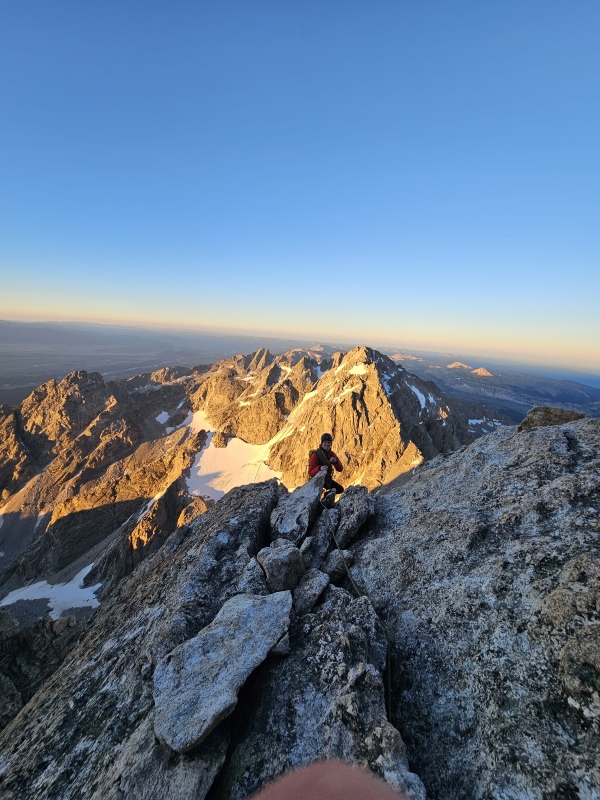
This would start a long section of scrambling as we simul-scrambled / short-roped ourselves up to the Wind Gully, and then did a mixture of simul-scrambling and short pitching with terrain belays while we navigated the high 4th class & low 5th class terrain of the Wind Gully. The "Boulder Problem" of the Wind Gully, reported on Wyoming Whiskey to be a 5.5 move, didn't feel too bad, and the exposure was fairly low, making it not quite as intimidating as other parts of the route. Unfortunately I don't have a photo of the Boulder Problem itself. Throughout the Wind Gully we encountered small sections of snow, but nothing consequential. 
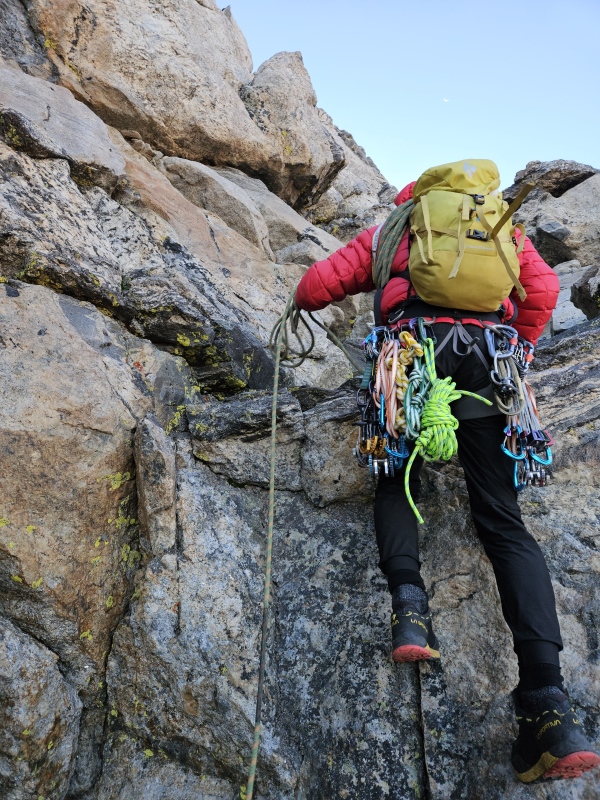
Just before the Jern Dihedral, we weren't quite sure where the route went, so we pitched out a short hand crack section, only to see the guided groups behind us go further east and avoid this section entirely, staying in 4th class terrain. I'm not upset about it though, I got a fun lead out of it, and it only added to the day. I think I placed only two or three cams. Yet again, I brought Nathan up behind me on a terrain belay, and then we moved up to the base of the Jern Dihedral. 
Upon reaching the Jern Dihedral, it was Nathan's turn to lead. He geared up and swiftly began up the pitch, placing three cams along the way. At this point, several guided groups had caught up and were passing us. Initially I hadn't expected this, but upon seeing their techniques, it became clear how they can move so quickly. The guides solo everything and use a terrain belay to bring up both clients simultaneously, immediately soloing the next section as soon as their clients reach a safe spot, only occasionally placing a cam to anchor their clients while they solo the next section. It's honestly a remarkable thing to watch. The guides from Exum guides were particularly friendly towards us and congratulated us on tackling this climb unguided. It was a nice confidence boost to be honest, and I really appreciated the stoke. Nathan brought me up after slinging a horn, where we again met up with the guided parties. 

We were now faced with the reported crux of the route, the Friction Pitch (5.5). We hadn't discussed who would be leading this pitch, but since Nathan had just got off lead, I started racking up and getting ready to take off. Although the climbing on the Friction Pitch isn't too difficult, it's slab climbing with some decently long run-outs over some pretty serious exposure. I took a few deep breaths and took off. I think I placed two cams the whole way, and at one point ended up about 20 feet above my last piece (a not so great 0.5 cam in a shallow crack), relying solely on shallow indentations in the rock as handholds, and the rubber of my approach shoes, to keep me on the rock. I certainly don't want to play it up and make it sound like it was anything too wild, but it definitely took some focus and composure on my part. Some actual rock shoes would've been appreciated, but as with most alpine climbing at this grade, it turned out to be much more of a mental game than anything else. Once I topped out, I scrambled across a downsloping ledge and again, threw the rope around a large horn and brought Nathan up on a terrain belay. 
We took in some chest coils and short roped ourselves up to the base of the V-Pitch. This is where we unintentionally took a variation that we had no intention of taking. Although we planned on taking the V-pitch, we thought we had to climb a short crack system to gain the V-pitch. We pitched out the crack system with Nathan on lead, which turns out is the "Crack Variation" to the V-pitch. Still fun climbing, and allowed us to quickly move on and access the next section. Nathan placed three cams along the way. 
From where Nathan belayed me up, we were unsure about the following low-angle section of slabby rock, so he threw me on belay and I continued up, placing a single cam as I went up an additional 20m or so until reaching a flat area. I threw him on a terrain belay and brought him up to me. We readjusted our chest coils and continued short roping each other to the base of the West Leaning Chimney. Here we found the cracks to be filled with snow and ice, making the moves a little dicey, but Nathan took the lead like a pro. He placed one cam in the chimney itself, another just above, and then brought me up at the top of the pitch with a two piece alpine anchor. 
Soon enough we found ourselves at the last pitch of the climb before the final scramble to the summit. This pitch, aptly named the Boulder Problem in the Sky, was in my opinion, the trickiest lead of the day. A hand crack dubbed the "Southern Jam Crack" leads you to the top of the boulder problem over some pretty airy exposure. I geared up and took the lead on this short pitch, and plugged three cams along the way. It was probably just the exhaustion setting in, but the crack just didn't feel great, so I had no hesitation in sewing it up. 



We shortened the rope to just 10m or so between us and scrambled along the east side of the "Horse", a false summit that lies just before the true summit. At approximately 1030 hours on Friday August 11th, we reached the summit of the Grand Teton, 13,775'. 
The Descent Although we had opted to climb the Upper Exum due to recent snow and ice on the upper mountain that made the Owen-Spalding a no-go, the standard descent regardless of ascent choice, is to descend the OS. We had brought microspikes with us and were hoping that between clever ropework and our spikes, that we could descend to the rappel stations without any hiccups. We began to follow a guided group down the OS, but soon enough, they decided to divert and take an alternative descent due to the guide not feeling comfortable taking his clients to the rappel station at the top of Sargent's Chimney. Despite the consistent snow cover, Nathan and I felt like our short roping techniques and spikes were providing us plenty of security and so we continued to the top of Sargent's. We set up the rappel, and quickly made our way down to the ledges below. As we rapped, the state of the chimney confirmed our decision to climb the Upper Exum instead of the OS, as it was full of water ice, some of which was several inches thick in places. 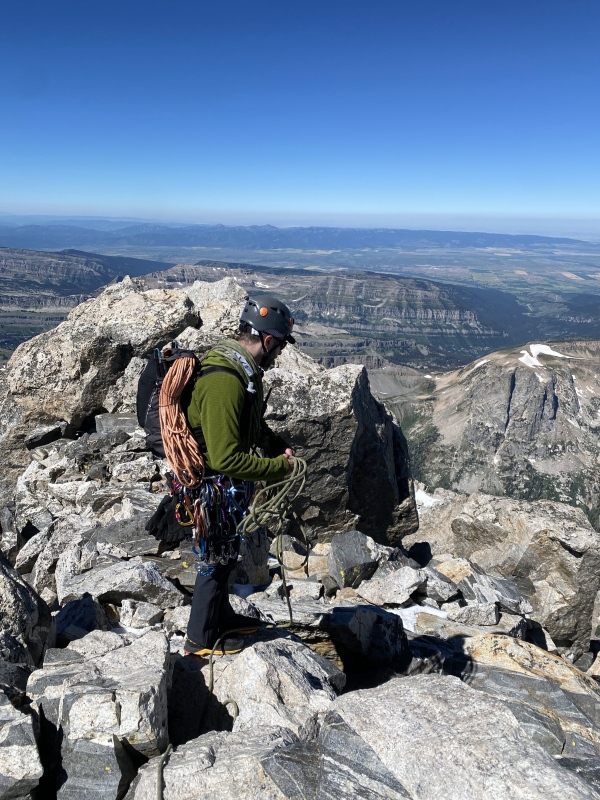

After we finished the rappel down Sargent's Chimney, we continued on to the main rappel. Here there are two maintained stations, one is a 40m rappel from bolts, and another is the "fire hose" station, with a reported 30m+ rappel. Although we brought a 60m rope, there are stories of people coming up short with a 60m rope. Right as we were approaching the rappel station to set up, another guided party appeared and told us that if we just make an effort to throw to the south over a ledge system, that along with rope stretch, our 60m rope should reach the bottom. Perhaps the responsible thing to do would have been to still use our tag line just in case, but this info seemed to be coming from a trusted source, so we set up our rappel just using our 60m climbing rope, and sure enough, with rope stretch I had just enough length to touch down below on a ledge just above the upper saddle. 


We began our descent down the 3rd & 4th class ledges back to the area of the Eye of the Needle. We found the Needle with ease at this point, passed through and continued our descent down the remaining 3rd class rock back to the trail that would take us back to the Lower Saddle.
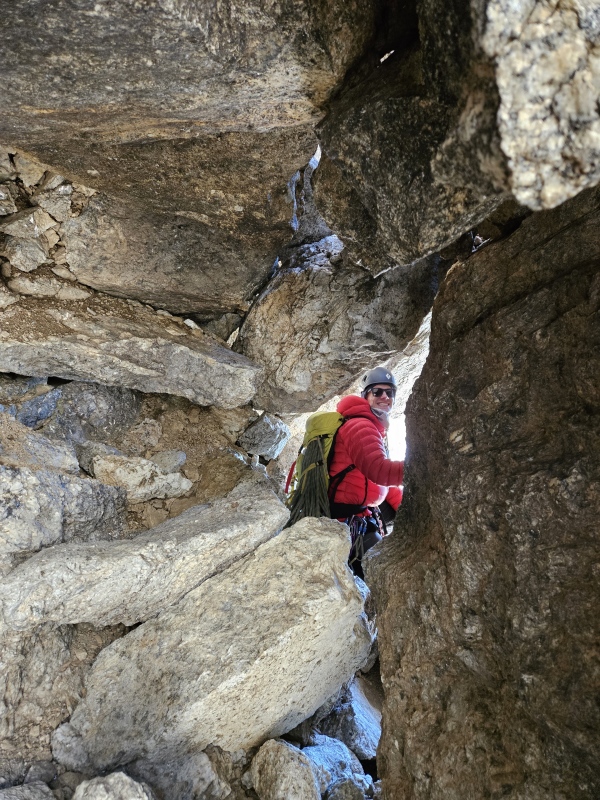
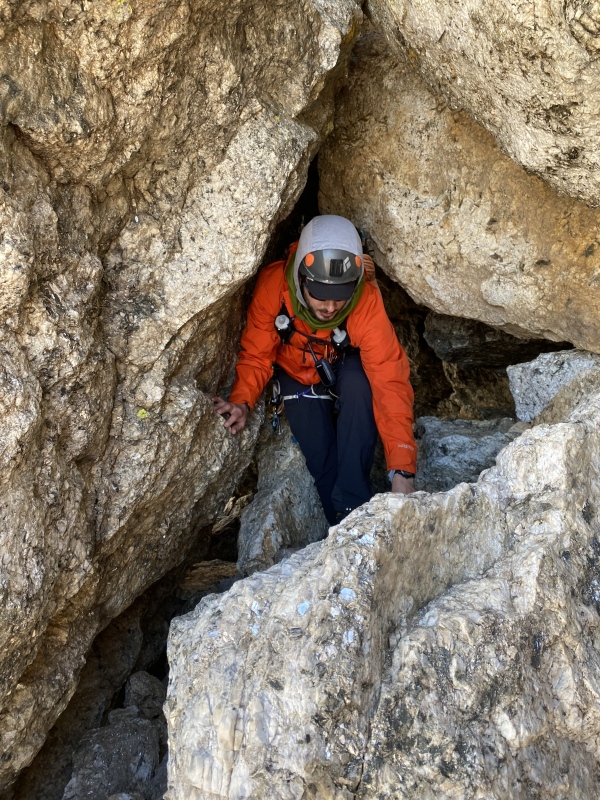
Upon reaching the Lower Saddle, we took a 30 minute break at the water source, filled up all our water and ate some well-needed calories before continuing back down the fixed lines and back to camp. Upon reaching camp, we broke down the tent, packed up our backpacking packs again, and began our descent back down into the valley. According to my Coros watch, we averaged 2.8 mph on our descent back to the trailhead, a testament to just how eager we were to go get some food and begin our drive back to Denver after a full day of climbing. Soon enough we reached the trailhead and high-tailed it to the closest Wendy's for large lemonades and food.
Final Thoughts It was such a pleasure to be able to summit the Grand Teton again, especially via a new-to-me route that presented us with the perfect opportunity to practice some new skills that we've acquired over the last few months. Routes like these are so much more than the YDS grade assigned to them, and scratch the itch of so many aspects of mountain climbing for me. Long approaches, navigating boulder fields, 3rd and 4th class scrambling, roped technical climbing, creative belays, long rappels, backpacking, living in a tent for multiple days, and so much more. I feel like the Grand Teton is such a great venue for aspiring alpine climbers to develop their skills while bagging one of the most picturesque mountains in North America. Climbing the Owen-Spalding several years ago with Matt was my first introduction to alpine technical climbing, and this trip only built on that in so many ways. For those considering climbing the Upper Exum, I'd recommend being comfortable trad climbing at least a few grades harder at your local crag since you'll likely be climbing in approach shoes, and be prepared for a huge day in the mountains with a ton of vertical gain, even if breaking it up into multiple days. Technical Gear 60m Sterling VR9 Rope Route Beta The most comprehensive beta for this route can be found on the Wyoming Whiskey blog found HERE GTNP Backcountry Camping Permits Info on GTNP Backcountry Camping Permits can be found HERE Thanks for Reading If you've made it this far, thanks for reading my report. Writing these reports has become a fun and cathartic way to look back on a big climb, and I hope that it will provide some help to someone else in the future that may be on a similar path as myself in the pursuit of alpine climbing. The Tetons have a lot to offer, and it always feels special to walk in the footsteps of so many famed alpinists that have climbed these routes before me. I'll likely make a few changes to this report over the next few days as I remember more details and fix my grammatical errors. Let me know if you have any questions. Thanks! |
| Comments or Questions | ||||||||||||||||||
|---|---|---|---|---|---|---|---|---|---|---|---|---|---|---|---|---|---|---|
|
Caution: The information contained in this report may not be accurate and should not be the only resource used in preparation for your climb. Failure to have the necessary experience, physical conditioning, supplies or equipment can result in injury or death. 14ers.com and the author(s) of this report provide no warranties, either express or implied, that the information provided is accurate or reliable. By using the information provided, you agree to indemnify and hold harmless 14ers.com and the report author(s) with respect to any claims and demands against them, including any attorney fees and expenses. Please read the 14ers.com Safety and Disclaimer pages for more information.
Please respect private property: 14ers.com supports the rights of private landowners to determine how and by whom their land will be used. In Colorado, it is your responsibility to determine if land is private and to obtain the appropriate permission before entering the property.
